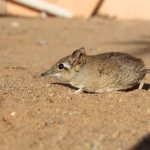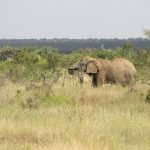Elephant-shrews, also called jumping shrews or sengis, are little-known African mammals that resemble shrews or rodents in appearance but are evolutionarily closer to elephants or sea sirens. An international team of zoologists, led by Josef Bryja from the Institute of Vertebrate Biology of the Czech Academy of Sciences, has now uncovered evolutionary relationships between individual groups of elephant-shrews using the largest available genetic dataset. The results prove how little we know about such important groups of organisms like mammals.
Most species of elephant-shrews live in savannas of sub-Saharan Africa. They resemble rats or overgrown shrews with an elongated nose that is why they are called “elephant-shrews”. Originally, they were classified as shrews or other insectivores, until genetic analyses from the beginning of the 21st century proved their close relationship with elephants and other Afrotherians.
Unlike elephants, very little is known about elephant-shrews. Last year, calm waters were stirred up by the rediscovery of the Somali sengi by American scientists who found its population in arid semi-deserts in Djibouti. Genetic analysis showed that the Somali sengi represent an evolutionarily ancient branch, and subsequently, they were assigned to a separate new genus Galegeeska. The genus was supposed to be distributed only in a small and very little explored area of Djibouti and Somaliland.
However, Czech scientists from the Institute of Vertebrate Biology of the CAS under the leadership of Josef Bryja and their colleagues from the University of South Bohemia in České Budějovice and the Severtsov Institute of the Russian Academy of Sciences in Moscow found that the mythical Somali sengi has a close relative. It is a Rufous Sengi, a widespread species in the Somali-Maasai savannah, which stretches from northern Tanzania to eastern Ethiopia, and it should be transferred to the recently erected genus Galegeeska. Both species are also similar in appearance – so why their close relationship was not discovered by the last year’s study that also included the Rufous Sengi?
“All previous genetic studies of elephant-shrews used sequences of the Rufous Sengi from the largest public database GenBank. And the scientists who entered them into the database 20 years ago misidentified the Rufous Sengi with another species living in eastern Africa”, Josef Bryja explains. “Although the amount of available genetic information on free-living species is constantly growing, many of it can be very misleading. It is therefore absolutely necessary to go again to places where the animals live and try to get not only new material for genetic analysis but also a comprehensive picture of their life and environment“, points out Josef Bryja. The results were published in the prestigious Journal of Zoological Systematics and Evolutionary Research.
To solve the phylogenetic relationships between individual groups of sengis, the researchers used molecular genetic approaches. “Preliminary analyses have already shown that there are genetically very distinct lineages of sengis in our material from East Africa, for which it would be necessary to find a new genus name. Therefore, we focused on the analysis of the complete material of this group“, says Jarmila Krásová, a Ph.D. student at the University of South Bohemia and the Institute of Vertebrate Biology of the CAS and the first author of the study. “Not only we have resolved the phylogenetic relationships between savannah sengis and reconstructed their evolutionary history, but as a by-product of this study we have also discovered several genetic populations that should be further researched and formally described as new species“.
During month-long field research in Angola, for example, scientists were able to obtain samples of two species of sengis, and at least one of them is clearly a new species for science. “The description of a new species is a timely process, so it will be a long-distance run“, says Jarmila Krásová. In the coming years, we can look forward to hot news from the world of East African mammals.
Contacts: doc. Mgr. et Mgr. Josef Bryja, Ph.D.
Institute of vertebrate biology of CAS
bryja@brno.cas.cz
+420 776 087 741
Photos to be download HERE.
PUBLICATION:
Krásová J., Mikula O., Šumbera R., Horáková S., Robovský J., Kostin D.S., Martynov A.A., Lavrenchenko L.A., Bryja J., 2021: The Rufous Sengi is not Elephantulus – Multilocus reconstruction of evolutionary history of sengis from the subfamily Macroscelidinae. Journal of Zoological Systematics and Evolutionary Research, in press. DOI: 10.1111/jzs.12460
https://onlinelibrary.wiley.com/doi/10.1111/jzs.12460





